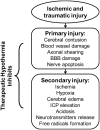Therapeutic hypothermia in stroke and traumatic brain injury
- PMID: 22207862
- PMCID: PMC3246360
- DOI: 10.3389/fneur.2011.00080
Therapeutic hypothermia in stroke and traumatic brain injury
Abstract
Therapeutic hypothermia (TH) is considered to improve survival with favorable neurological outcome in the case of global cerebral ischemia after cardiac arrest and perinatal asphyxia. The efficacy of hypothermia in acute ischemic stroke (AIS) and traumatic brain injury (TBI), however, is not well studied. Induction of TH typically requires a multimodal approach, including the use of both pharmacological agents and physical techniques. To date, clinical outcomes for patients with either AIS or TBI who received TH have yielded conflicting results; thus, no adequate therapeutic consensus has been reached. Nevertheless, it seems that by determining optimal TH parameters and also appropriate applications, cooling therapy still has the potential to become a valuable neuroprotective intervention. Among the various methods for hypothermia induction, intravascular cooling (IVC) may have the most promise in the awake patient in terms of clinical outcomes. Currently, the IVC method has the capability of more rapid target temperature attainment and more precise control of temperature. However, this technique requires expertise in endovascular surgery that can preclude its application in the field and/or in most emergency settings. It is very likely that combining neuroprotective strategies will yield better outcomes than utilizing a single approach.
Keywords: hypothermia; neuroprotection; stroke; traumatic brain injury.
Figures
Similar articles
-
Overview of therapeutic hypothermia.Curr Treat Options Neurol. 2012 Dec;14(6):541-8. doi: 10.1007/s11940-012-0201-x. Curr Treat Options Neurol. 2012. PMID: 23007950 Free PMC article.
-
Cooling the injured brain: how does moderate hypothermia influence the pathophysiology of traumatic brain injury.Curr Pharm Des. 2007;13(22):2310-22. doi: 10.2174/138161207781368756. Curr Pharm Des. 2007. PMID: 17692002 Review.
-
Modeling selective therapeutic hypothermia in case of acute ischemic stroke using a 1D hemodynamics model and a simplified brain geometry.Math Biosci Eng. 2019 Nov 15;17(2):1147-1167. doi: 10.3934/mbe.2020060. Math Biosci Eng. 2019. PMID: 32233574
-
Staying Cool in Space: A Review of Therapeutic Hypothermia and Potential Application for Space Medicine.Ther Hypothermia Temp Manag. 2022 Jun;12(2):115-128. doi: 10.1089/ther.2020.0041. Epub 2021 Feb 22. Ther Hypothermia Temp Manag. 2022. PMID: 33617356 Review.
-
Hypothermia Used in Medical Applications for Brain and Spinal Cord Injury Patients.Adv Exp Med Biol. 2018;1097:295-319. doi: 10.1007/978-3-319-96445-4_16. Adv Exp Med Biol. 2018. PMID: 30315552 Review.
Cited by
-
Hypothermia evoked by stimulation of medial preoptic nucleus protects the brain in a mouse model of ischaemia.Nat Commun. 2022 Nov 12;13(1):6890. doi: 10.1038/s41467-022-34735-2. Nat Commun. 2022. PMID: 36371436 Free PMC article.
-
Regional hypothermia inhibits spinal cord somatosensory-evoked potentials without neural damage in uninjured rats.J Neurotrauma. 2013 Aug 1;30(15):1325-33. doi: 10.1089/neu.2012.2516. Epub 2013 Jul 16. J Neurotrauma. 2013. PMID: 22916828 Free PMC article.
-
Brain temperature: physiology and pathophysiology after brain injury.Anesthesiol Res Pract. 2012;2012:989487. doi: 10.1155/2012/989487. Epub 2012 Dec 26. Anesthesiol Res Pract. 2012. PMID: 23326261 Free PMC article.
-
Disease-directed engineering for physiology-driven treatment interventions in neurological disorders.APL Bioeng. 2019 Oct 23;3(4):040901. doi: 10.1063/1.5117299. eCollection 2019 Dec. APL Bioeng. 2019. PMID: 31673672 Free PMC article.
-
Prolonged Local Hypothermia Has No Long-Term Adverse Effect on the Spinal Cord.Ther Hypothermia Temp Manag. 2015 Sep;5(3):152-62. doi: 10.1089/ther.2015.0005. Epub 2015 Jun 9. Ther Hypothermia Temp Manag. 2015. PMID: 26057714 Free PMC article.
References
-
- Abate M., Cadore B., Citerio G. (2008). Hypothermia in adult neurocritical patients: a very hot strategy not to be hibernated yet! Minerva Anestesiol. 74, 425–430 - PubMed
-
- Adelson P. D., Ragheb J., Muizelaar J. P., Kanev P., Brockmeyer D., Beers S. R., Brown S. D., Cassidy L. D., Chang Y., Levin H. (2005). Phase II clinical trial of moderate hypothermia after severe traumatic brain injury in children. Neurosurgery 56, 740.10.1227/01.NEU.0000156471.50726.26 - DOI - PubMed
-
- Akaji K., Suga S., Fujino T., Mayanagi K., Inamasu J., Horiguchi T., Sato S., Kawase T. (2003). Effect of intra-ischemic hypothermia on the expression of c-Fos and c-Jun, and DNA binding activity of AP-1 after focal cerebral ischemia in rat brain. Brain Res. 975, 149–15710.1016/S0006-8993(03)02622-2 - DOI - PubMed
LinkOut - more resources
Full Text Sources
Other Literature Sources


